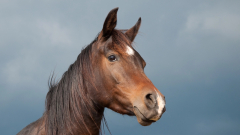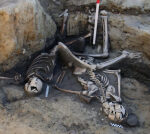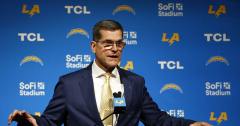Get the Popular Science daily newsletter💡
Breakthroughs, discoveries, and DIY tips sent every weekday.
Have you ever noticed that horses have eyes on the sides of the head rather than the front, like we do as humans?
The location of horses’ eyes offer a biological advantage that helps keep them safe as prey animals. In fact, eye placement signals whether an animal is a predator or prey. Predators typically have eyes on the front of their heads, while prey animals’ eyes are set to the sides. Since humans have eyes on the front of their faces, they are technically predators in a horse’s world.
“If you think about a tiger or a bird of prey, they have to focus in and target something they’re trying to catch for food,” said Beau Whitaker, an equine veterinarian at Brazos Valley Equine Hospitals in Salado, Texas. “They have minimal blind spots, so they can focus directly on what’s in front of them.”
Horses’ side-set eyes give them a wide field of vision—an advantage when scanning the environment for predators. Although most domestic horses today live in predator-free or low-predator environments, they still process visual information as if their survival depended on it.
How horses see
Because of their eye placement, horses have both monocular and binocular vision. According to the University of California Davis Ophthalmology department, monocular vision is like a panoramic view with each eye viewing about a 200-210-degree arc until a horse raises their head, at which time their field of vision narrows to a binocular view of about 55-80 degrees.
This wide peripheral range of vision allows them to detect subtle movements long before a predator reaches them. Monocular and binocular vision combined gives them close to 350-degree vision around their body. For comparison, humans can see about 180 degrees without turning their heads.
“The biggest thing to know is that horses have a blind spot about four feet in front of them and directly behind them,” Dr. Whitaker explained. “Humans have a tiny blind spot too, that is like a black hole, but our brain fills in what is expected to be there.”
While they have an incredible field of vision, horses process information differently than humans. When you look at an object, both eyes see and process the information at the same time. However, the horse’s eyes process information independently. So, when they see something with their left eye for the first time, even if their right eye has already viewed it, it’s like seeing the same object for the first time.
“The way horses’ eyes connect with the brain means they’re not necessarily learning holistically,” said Dr. Whitaker. “People who work with horses have probably experienced this, where you often hav





